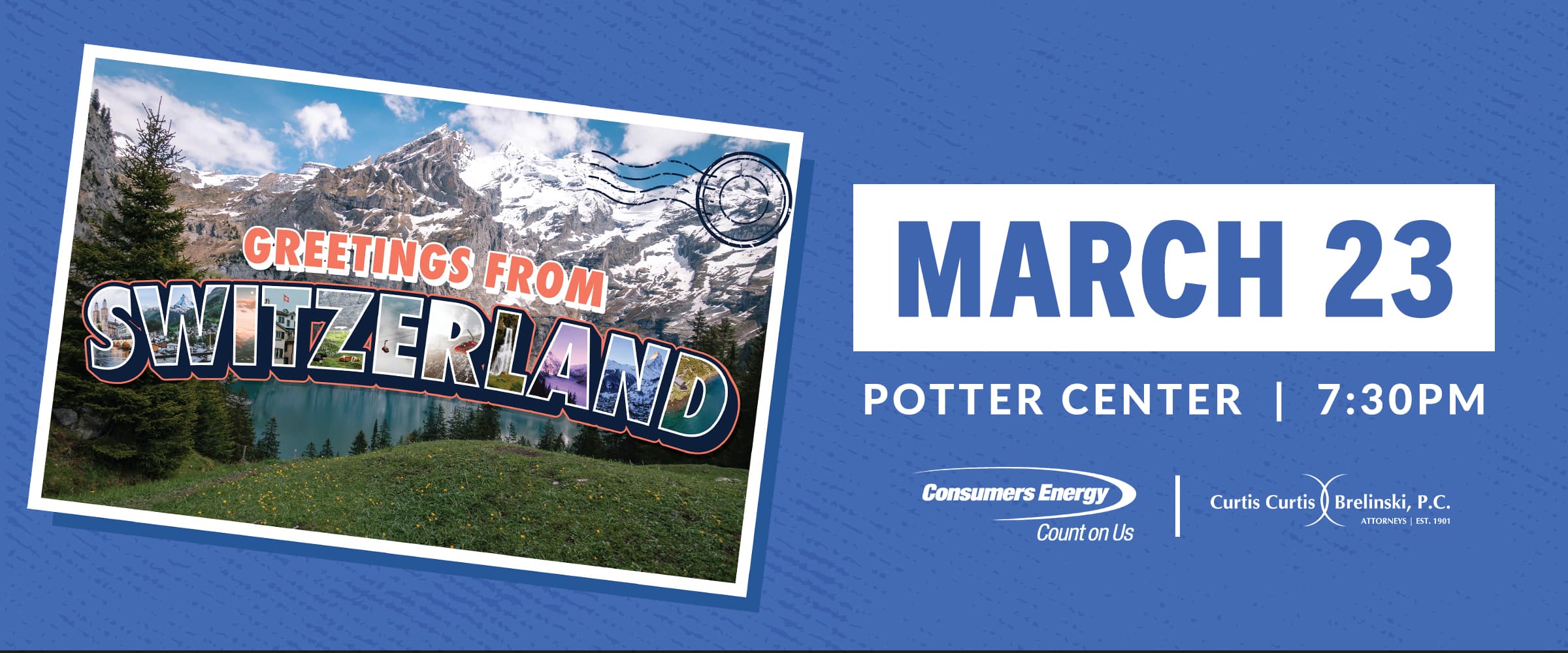
PROGRAM NOTES
March 23, 2024
By Composer in Residence
Bruce Brown
Switzerland shares borders with Germany, Austria, France, and Italy. War torn Ukraine and Russia lie to the east. People and ideas – including musicians and their music – often circulate freely around this part of the world. The JSO’s March concert, “Greetings from Switzerland,” will present a fascinating mix of pieces from in and around this small, mighty nation.
One highlight will be an exciting concerto by Pierre Wissmer, a Geneva-born composer whose career took him all over the world. French virtuoso Eva Zavaro will take the stage to perform Wissmer’s Violin Concerto No.2, a work she played in Ukraine as their conflict was beginning.
Mlada: Procession of the Nobes (Cortège)
Passion for developing uniquely Russian music drew Nikolai Rimsky-Korsakov (1844-1908) into a group often called The Five, or The Mighty Handful. He and his colleagues – Mily Balakirev, César Cui, Modest Mussorgsky, and Alexander Borodin – turned away from traditional compositional styles to focus on writing that honored Russian folk songs and legends. They toiled endlessly to discover exotic, new harmonic, melodic and rhythmic sounds, an approach often called “musical orientalism.”
Rimsky-Korsakov’s nationalistic works exerted tremendous influence on other composers, and his profound knowledge of musical instruments helped him create dazzling, popular works like Cappriccio Espagnol, Russian Easter Overture, and Scheherazade.
His Procession of the Nobles comes from Mlada, written between 1889 and 1890, an “opera-ballet” based on a wildly complex tale set a thousand years ago in a fictional kingdom. He, Cui, Borodin and Mussorgsky had been commissioned twenty years earlier to join forces in creating a similar extravaganza, but the project fell through. All four composers incorporated what they’d written into other works.
Mlada faded into obscurity, but the Procession of the Nobles – the introduction to Act II, which begins with a festival of merchants and townsfolk – has become an enduring favorite.
Les Eaux célestes
Camille Pépin (born in 1990) is a fresh, exciting voice in the world of contemporary classical music. Orchestras across the globe, including the National Orchestra of France, the BBC Symphony, and the Toronto Symphony have performed her colorful, evocative compositions, which she says lie “at the crossroads of French impressionism and American repetitive music.”
Her 2017 piece, Lyrae, performed by the ConTempus Quartet with dance interpretation by Ballet Chelsea, delighted Jackson audiences in February of 2023.
Pepin’s Les Eaux célestes, written in 2023, was inspired by an ancient Chinese legend adopted into Japanese folklore in the eighth century. Its two main characters are Orihime, the sky god’s daughter, who weaves clothing from clouds, and Hikoboshi, a youth herding cows among the stars.
These young lovers neglect their important tasks until the sky god places “a great celestial river” – the milky way – between them. The princess’s bitter tears “create small pearls of light in the sky.” The sun god, moved, allows them to meet once a year, on the seventh day of the seventh month, but they cannot cross the gulf separating them. Finally, flocks of birds create a bridge with their wings, and the lovers are reunited.
Violin Concerto No.2
The diverse career of Swiss-born composer Pierre Wissmer (1915-1992) included teaching at the Geneva Conservatory and Schola Cantorum in Paris, leadership of the Le Mans National Music School, supervising programming for radio and television in Luxembourg, and service in a French artillery unit during World War II.
After the broadcast of his first piano concerto in 1937, and the premiere of his first symphony the following year, Wissmer became acquainted with Igor Stravinsky, Francis Poulenc and Jean Cocteau. Many successes followed, including receiving the Grand Prix of the City of Paris.
Wissmer composed nine symphonies and works in many other genres. He wrote three concertos for violin, one in 1944, the second in 1954, and the last in 1987. When asked about his compositions, Wissmer insisted “all details of performance [need] the clockmaker’s precision and the Benedictine’s patience, both led by the water diviner’s intuition.”
Eva Zavaro recorded Wissmer’s second concerto with the Hungarian Symphony in 2018. In his liner notes, Jacques Tchamkerten wrote:
In the 1950s, the language of Pierre Wissmer gradually changed: its … shimmering harmony gave way to a more inner expression, … the Concerto No. 2 falls within this evolution. [Wissmer’s] natural fantasy and the ardor …[express] themselves fully in the ending Allegro con spirito … whose inventiveness and enthusiasm are ever-present until its final chord.
Tzigane, rapsodie de concert
In 1924, Maurice Ravel (1875-1937) suffered from terrible writer’s block. Then he remembered hearing a dazzling private recital by Hungarian violinist Jelly d’Arányi. Ravel had persuaded her to play Gypsy pieces deep into the night.
In a burst of renewed energy, Ravel produced his Tzigane, a piece for violin accompanied by piano with a luthéal attachment. This device created different tone colors when stops were pulled on the keyboard. A sound imitating a cimbalom – a trapezoidal box with metal strings, still played in many countries, including Ukraine – suited Ravel’s new music perfectly.
The luthéal proved to be a short-lived fad. But Tzigane, which Ravel dedicated to d’Arányi, became popular with piano alone. Ravel orchestrated the accompaniment, and Pierre Monteux premiered that version with the Concertgebouw Orchestra and soloist Samuel Dushkin on October 19, 1924.
The title, Tzigane, came from a popular European term for “Gypsy.” Ravel didn’t include any authentic Roma tunes in his new work, though. People of the time associated Gypsies more with a popular style of exoticism than their authentic heritage.
Symphony No.2, B Minor
During his lifetime, Alexander Borodin (1833-1887) was better known for scientific exploits than music. He spent most of his time as a professor of chemistry in the Academy of Medicine and Surgery in St. Petersburg, but his fame eventually grew as a member of The Five, that group with Rimsky-Korsakov.
Borodin started composing his second symphony in 1869, immediately after the success of his first one. That summer he was also toiling on Prince Igor, an opera based on a 12th-century epic. He quit in frustration, believing he couldn’t write a satisfactory libretto. Borodin returned to his symphony, incorporating material he’d written for Prince Igor. He finsihed most of the first movement in April of 1870 and wrote drafts of the other three movements the following summer and fall.
Then, the Director of the Imperial Theatres, Stephan Gedenov, asked him to collaborate on that extravagant opera-ballet, Mlada, with Cui, Mussorgsky, and Rimsky-Korsakov. When the project got cancelled, Borodin turned back to his symphony again, but work demands kept him from completing it until 1875.
That autumn, the Russian Musical Society enquired about performing the symphony, which musicologist Peter Brown said “proved to be Borodin’s great work.” The composer found – to his horror – that the score had been lost! He found the middle movements but had to reconstruct the other two from scratch. Borodin revised the score in 1879, thinning out the brass parts. In 1886, he made further changes based on advice from Rimsky-Korsakov
Borodin told his friend Vladimir Stasov the symphony portrays knights and heroic figures of ancient Russia. The first movement, he said, depicts an assembly of Russian knights. The scherzo is a headlong chase or festive scene. The third movement captures spirit of an 11th century minstrel, Boyan, accompanying himself on an instrument called a gusli represented by the harp. In the finale, the knights feast and jubilant townsfolk join the celebration. Stasov dubbed the work Bogatirskaya simfoniya – “Heroic symphony” – and the nickname stuck.
PROGRAM SCHEDULE
| RUNTIME: 1H 45M |
